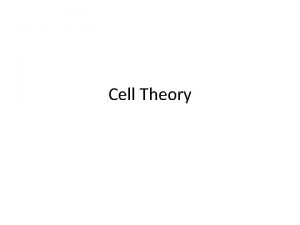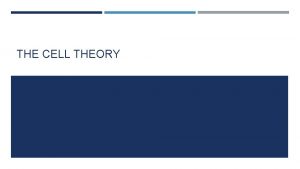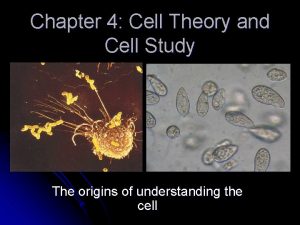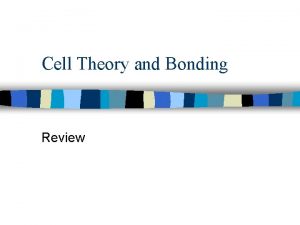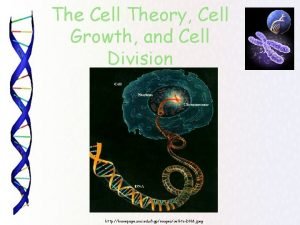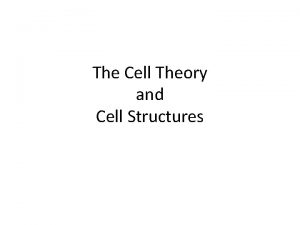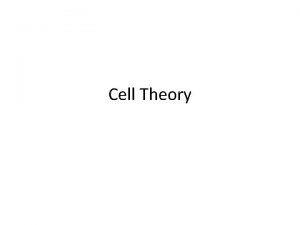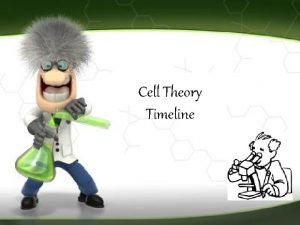Cell Theory and Cell Study The Cell Theory














- Slides: 14

Cell Theory and Cell Study

The Cell Theory • The cell is the basic unit of structure of all living things. • All living things are made up of cells. • The cell is the basic unit of function of all living things. • Cells come from pre-existing cells.

Exceptions to the Cell Theory • These are facts that can not be explained by the Cell Theory. • Viruses are not made up of cells, but they do contain genetic material. • The first cell could not have arisen from a previously existing cell, Scientists don’t know the origin of the first cell.

History of Cell Study • Scientists did not know much about cells until the discovery of the microscope. • Cells are so small they can not be seen w/o a microscope. • Anton van Leeuwenhoek- Dutch naturalist (1600’s). Developed the first microscope. • Robert Hooke- English (1665) was the first to develop a compound microscope. He came up with the term cell.

History cont…. . • Robert Brown- (1831) discovered the nucleus of the cell. • Matthias Schleiden- (German, around 1830’s) a Botanist, concluded that all plants were made up of cells. • Theodor Schwann- (German, worked during the same time as Schleiden), studied animal cells. Concluded that animals were made up of cells. • Rudolf Virchow- (1858) concluded that all new cells must come from previously existing cells.

Let’s Go to the Video!

More Video !

Tools and Techniques

The Compound Microscope • Microscopes are used to study materials that can’t be seen with the naked eye. • Microscopes use two lenses (compound microscope) to increase the size of a specimen. • A specimen must be thin enough for light to pass through it. • The total magnification of an object is found by multiplying the magnification of the objective x the magnification of the eyepiece.

The Dissecting Microscope • Allows the study of large specimens. • It has two eyepieces and two objectives. • It has low power magnification and 3 D quality. • It is also called a Stereo-microscope.

The Electron Microscope • Can magnify up to 100, 000 x. • Cannot use live specimens. • Use a narrow beam of electrons instead of light. • Magnets are used to focus the electron beam.

Magnification • Compound microscopes- each lens enlarges the image. • Total magnification is determined by multiplying the power of the eyepiece lens x the power of the objective lens. • Total magnification refers to the total amount the image is enlarged. • The unit of length used to measure specimens is the micrometer (u).

Staining Techniques • Many parts of the cell are colorless and hard to see. • Staining techniques “color” certain cell parts so they can be more easily studied. • The most commonly used stains are Methylene Blue, and Iodine (Lugol’s Solution).

The Centrifuge • Instrument used to separate cell parts. • Separate parts according to density. • Material is spun around in a test tube at very high speeds. • Heaviest material is at the bottom, lightest is at the top.
 Chapter 4 cell theory and cell study
Chapter 4 cell theory and cell study Hát kết hợp bộ gõ cơ thể
Hát kết hợp bộ gõ cơ thể Slidetodoc
Slidetodoc Bổ thể
Bổ thể Tỉ lệ cơ thể trẻ em
Tỉ lệ cơ thể trẻ em Gấu đi như thế nào
Gấu đi như thế nào Glasgow thang điểm
Glasgow thang điểm Chúa yêu trần thế alleluia
Chúa yêu trần thế alleluia Các môn thể thao bắt đầu bằng tiếng chạy
Các môn thể thao bắt đầu bằng tiếng chạy Thế nào là hệ số cao nhất
Thế nào là hệ số cao nhất Các châu lục và đại dương trên thế giới
Các châu lục và đại dương trên thế giới Cong thức tính động năng
Cong thức tính động năng Trời xanh đây là của chúng ta thể thơ
Trời xanh đây là của chúng ta thể thơ Mật thư tọa độ 5x5
Mật thư tọa độ 5x5 Làm thế nào để 102-1=99
Làm thế nào để 102-1=99















